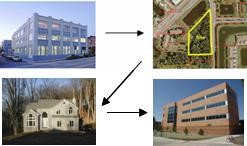1031 Exchange Guidelines
Strict adherence to the guidelines set forth within the tax code is required for a successful exchange. Investors should be aware of four basic requirements when entering into a delayed exchange, and should seek the advice of their tax accountant or attorney to ensure proper adherence to the tax code. The four basic requirements for a successful exchange are:
Property Qualifications
 The internal revenue code requires that the properties involved in an exchange must be held for productive use in trade or business or for investment, and they must be "like-kind".
The internal revenue code requires that the properties involved in an exchange must be held for productive use in trade or business or for investment, and they must be "like-kind".
The 'like-kind" requirement is often a source of confusion for investors. All real estate can be like-kind, with the exception of real estate outside the United States. For example, provided the properties are within the U.S., an investor selling a rental home can exchange into a four-plex. Similarly, an investor selling a warehouse can exchange into a percentage interest in an office building.
Dealer property, or property held as inventory does not qualify for an exchange. The most important factor in determining whether a property is dealer property or inventory is "intent". Upon an audit the IRS will take a careful look at what the investor intended to do with the property at the time of acquisition. If the IRS feels that the intent of the investor was to quickly resell the property, it could be considered dealer property, or inventory, and ineligible for exchange.
Timeline
The IRS provides a maximum of 180 days to complete an exchange. The timeline begins upon the close of escrow (COE) of the relinquished property. The replacement property (or properties) must be acquired on or before midnight of the 180th day. No Exceptions! In addition the IRS requires that all potential replacement property be identified by midnight of the 45th day.
If the replacement property (or properties) can not be acquired on or before day 180, the exchange will fail and taxes must be paid.
Proper planning is essential for a successful exchange.

Identification Rules
Identification of all potential replacement property is required on day 45 of the exchange. Identification must be in writing and the description of the properties must be unambiguous. The IRS provides two rules for identifying replacement property:- The 3 Property Rule – The 3 Property Rule allows for identification of any three properties, of any price, anywhere in the United States.
- The 200% Rule - The 200% Rule is an option for identifying more than three properties. With the 200% Rule four or more properties can be identified, however the combined value of all properties identified can not exceed 200% of the property sold. For example:
- Investor A sells a rental home for $500,000. Investor A can identify ten $100,000 rentals, five $200,000 rentals or any combination of properties, provided the aggregate value does not exceed $1,000,000.
100% Tax Deferral
To defer 100% of the capital gains tax liability, two requirements must be met:- Reinvest all the cash that was generated from the sale of the relinquished property and;
- Purchase property equal or greater in value to the relinquished property.

A partial exchange is also possible. A partial exchange occurs in a trade down situation, where the replacement property is of less value than the relinquished property (i.e. sell for $500,000 buy for $400,000). A partial exchange will result in a partial deferment of the tax liability. Some but not all of the taxes will be owed.

